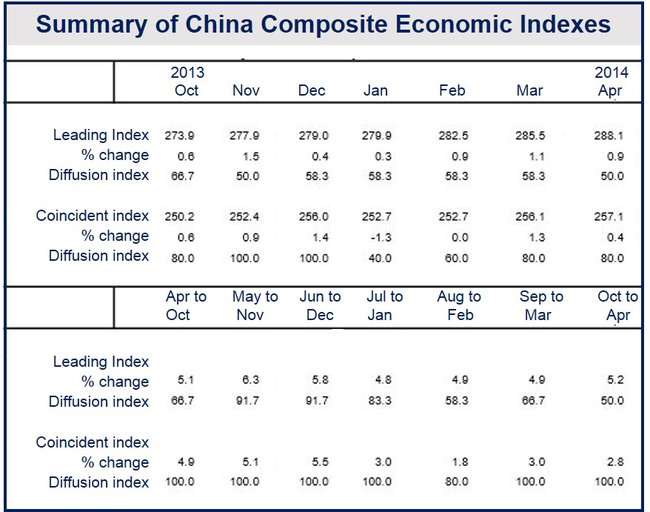The Chinese economic outlook improved in April, with The Conference Board Leading Economic Index (LEI) rising by +0.9%, after a +1.1% increase in March and +0.9% in February. The LEI stands at 288.1 (2004=100). Of the six LEI components, three contributed positively to April’s figures.
Andrew Polk, resident economist at The Conference Board China Center in Beijing, said:
“The LEI for China increased in April, but its overall expansion remains weaker than the latter half of 2013 and underlying volatility in the economy has increased.”
“Subdued LEI growth, combined with growth rates in industrial activity and retail sales running at their lowest since 2004, suggest that the slower trend of economic growth will continue into the third quarter at least.”
Chinese Leading Economic Index (LEI) for April
The LEI for China in April’s increase was mainly driven by total loans issued by financial institutions and floor space started. Over the six-month period ending on April 30th, 2014, the LEI increased by 5.2% (approx. 10.6% annually), roughly the same rate as during the previous six months.
Over a six-month period ending in April, the strengths among the leading indicators were less widespread than before, and were balanced with the weaknesses.
Of the six components that make up the LEI, the following made a positive contribution in April, in order of the size of their impact:
- Total floor space started.
- Total loans issued by financial institutions.
- The 5000 industry enterprises diffusion index: raw material supply index.
The following components had a negative impact:
- The consumer expectations index.
- The PMI new export orders index.
- The (inverted) PMI supplier delivery index.
(The Conference Board)
Chinese Coincident Economic Index (CEI) for April
Of the five components that make up the CEI, four made a positive contribution to April’s figures.
The positive contributors, in order of the size of their impact, were:
- Retail sales of consumer goods.
- Manufacturing employment.
- Value-added industrial production.
- Electricity production.
The volume of passenger traffic fell in April.
After April’s +0.4% increase, China’s CEI stands at 257.1 (2004=100). Over the six-month period ending on April 30th, the CEI rose by +2.8%, with all five components contributing positively.
Mixed data from China
So far this year, economic data coming out of China has been mixed. The National Bureau of Statistics informed that GDP growth in Q1 2014 was 7.4%, less than the 7.7% in Q4 2013. The first quarter results, however, were better than economists had forecast.
After a steep import-export decline in March, international trade improved in April.
April housing figures worried investors. The total number of cities reporting higher new home prices was the lowest in one-and-a-half years, as developers started reducing prices.


